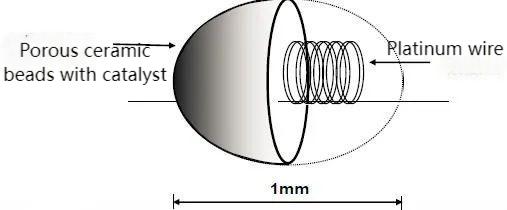

 News
News Industry News
Industry NewsCatalytic combustion sensors, known for their reliability and excellent field performance, are widely used in industrial, coal mining, and civilian applications for qualitative, semi-quantitative, and quantitative detection of flammable and explosive gases or organic vapors within the lower explosion limit concentration range.
As we all know, sensors are fragile electronic components. During use, they can experience zero drift due to various reasons. Today, Dasheng will explain why this phenomenon occurs.
Zero drift occurs when the input signal of an amplifier circuit is zero (i.e., no AC input), but due to factors such as temperature fluctuations and unstable power supply voltage, the static operating point changes. This is then amplified and transmitted in stages, causing the circuit's output voltage to deviate from its original fixed value and drift. Catalytic sensor zero drift may be caused by the following reasons:
①
The aging time before calibration was too short, not according to the time specified in the sensor manual. Calibration was performed before the sensor was fully stabilized.
Generally speaking, catalytic sensors stabilize after 8 hours of short-term storage (less than two weeks). For long-term storage (one year), 48 hours of aging are required.
②
The sensor's operating environment is complex, affecting its zero point and sensitivity.
Catalytic sensors must be protected from exposure to volatile silicon vapors and highly corrosive environments. They must also avoid contamination from alkalis, alkali metal salts, and halogens. (Each sensor's instruction manual contains instructions for use; please read carefully before use.)
③
The sensor's operating environment is subject to unstable temperature and humidity conditions.
Extremely fluctuating temperature and humidity conditions can cause significant sensor zero point and sensitivity drift. For example, if the sensor is calibrated under standard operating conditions but then operated under extreme conditions, this can cause the sensor's zero point and sensitivity to drift.
④
The sensor's operating voltage that deviates from the specified voltage can also affect its zero point and sensitivity.
For example, if the sensor is powered by a battery, the output voltage may drop below the nominal value after a period of use, potentially causing the sensor to experience zero drift.
⑤
The sensor is subject to severe vibration or destructive external forces.
As mentioned earlier, sensors are relatively precise electronic components. When subjected to severe vibration or destructive external conditions, this can cause the sphere's position to shift, resulting in a zero point shift. Alternatively, the platinum wire coil can be pulled out of the sphere, loosening the leads and causing the sphere's position to shift, leading to a zero point shift.

The above are the common reasons for catalytic sensor zero drift. I hope it can help you. If you have other questions, please feel free to contact us:
Email: [email protected]
Tel/WhatsApp: 86 18335818384